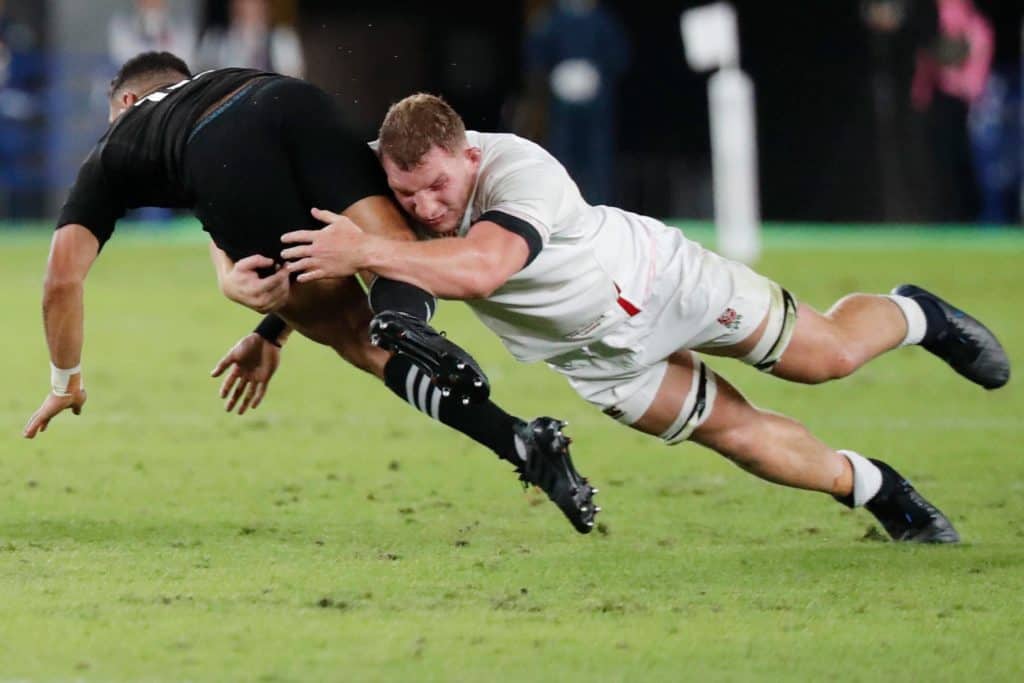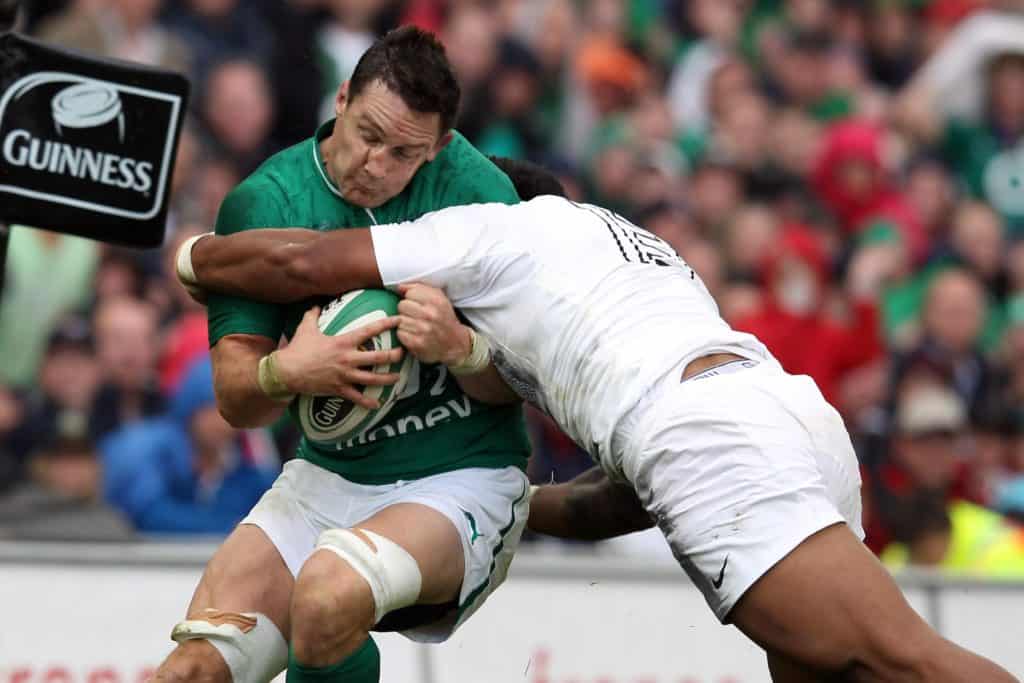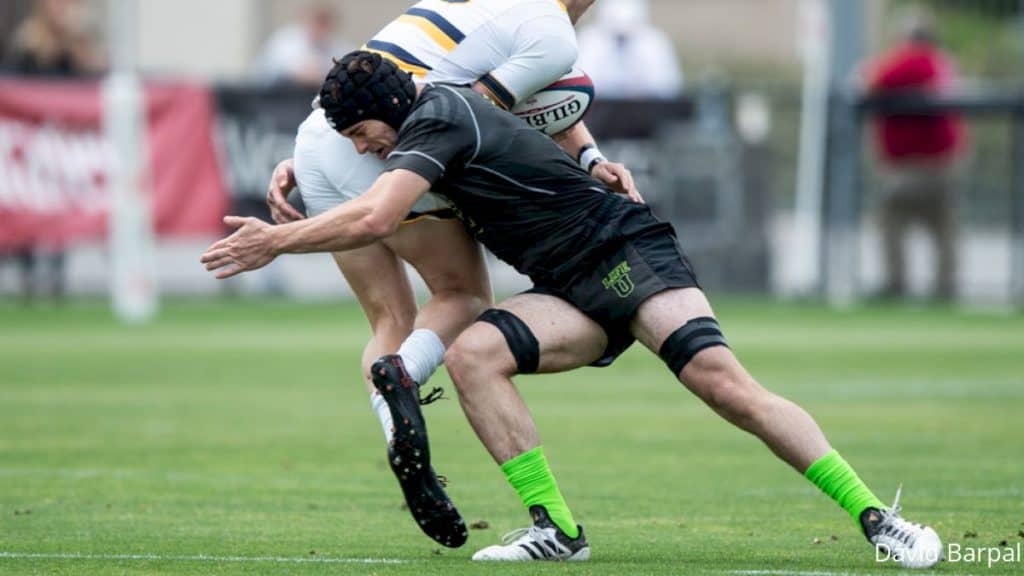Tackling is a fundamental aspect of rugby. It is the most common and effective way to prevent the opposition side from scoring. If you want to play the great game then you need to know how to tackle.

How to rugby tackle?
To perform a rugby tackle you must drop your hips, bend your knees while maintaining a straight back. Then in a staggered stance get your lead foot close to the ball runner. Once in position drive off your back foot, hit your opponent with your shoulder between their thigh and rib cage. Then secure their legs with your arms and drive with your legs until they fall over.
Rugby tackling may look like two giant men simply running into each other at blistering speeds but there is actually a lot of subtle technique involved. Correct rugby tackling technique can be the difference between a broken tackle and a dominant tackle which sends the ball runner flying backwards and looking up at the heavens from his backside.
The first thing you need to get right if you want to learn how to tackle is body positioning. It doesn’t matter how strong you are or how explosive you are, if your body positioning is wrong you will never be a good tackler.

You need to stand in a staggered stance, where you have one foot in front of the other. The staggered stance allows you to generate maximum force as you use your back foot as a spring which you push off from. The staggered stance also maximises your balance as your backfoot prevents a strong ball runner from stampeding over the top of you. Your back foot keeps you firmly planted to the ground.
Which foot you have forward depends on where the ball runner is heading. If the ball runner is running to left then you have your left foot forward and vice versa. When you are in a staggered stance the goal is to step your front foot as close to your opposition as possible while having your weight on your backfoot. When you get your front foot in position you then drive off your backfoot to ensure you make solid contact.
You can not stand upright. To perform a perfect rugby tackle you need to drop your body height. This isn’t done by bending your back, which is a common mistake among beginners. Instead you need to bend your legs and squat. This takes a lot of leg strength to perform this correctly throughout a game, don’t be surprised if you find your legs are regularly on fire. This is a sign you are doing it correctly.
Once you have dropped your body height you need to maintain a straight back. A bent back prevents you from transferring your force effectively to your opponent during a tackle and places you at a higher risk of injury as your discs are weaker when they are rounded. You also need to maintain a straight neck. Your neck should be tilted slightly up which puts your head in the strongest position.
Once you are in the perfect position to perform a rugby tackle it is time to make contact with your opposition. To generate power you push off your backfoot and then drive your shoulder into your opposition’s body. You aim to make contact from the lower rib cage to the thigh area. You need to make sure your head is outside your opponent’s body. Many rugby players suffer concussions because their head gets hit by their opposition’s knee or hip.

Once you make contact you may be tempted to stop, don’t. You need to continue to drive through the tackle. Use those legs and run through your opponent. Keep your head slightly up and run your opponent in a diagonal direction. After you have made solid contact, wrap your arms around your opposition’s legs, squeeze their legs together tightly, bring your elbows together to make it extra secure and keep driving until they fall over.
Remember you want to take your opposition down in the opposite direction to where your head is otherwise you risk a neck injury when the ball runner falls on you.
Once you have brought the attacker to the ground your job is not down. Release the player. Then jump to your feet and get in position to force a turnover at the breakdown.
How To Avoid Injuries During A Rugby Tackle?

To avoid an injury during a rugby tackle you need to keep a straight back and neck, ensure your head is outside your opponent’s body, get close to your opposition before starting a tackle and make contact with your shoulder first.
The most common serious injuries rugby players suffer when tackling is neck and head injuries, particularly concussions. These occur when rugby players get their heads in the wrong position when making contact. Their heads will often get hit by the attacker’s hip, knee or thigh. Head injuries also occur when a rugby player does not finish the tackle correctly and the ball carrier falls towards the tackler’s head, crushing their neck.

Fortunately, these injuries can be easily avoided by making sure whenever you are tackling you keep your head outside your opposition’s body and you always finish the tackle by taking your opposition down to the side which is opposite to where your head is located. Whenever you are tackling you need to make a conscious effort to know where your head is at all times. You must keep well away from a stampeding player as the contact can lead to a serious concussion.
The shoulder is a strong part of the body and can handle a lot of abuse. This is why when making a rugby tackle your shoulder should be your first point of contact. If you try to make contact with smaller weaker parts of your body such as your arms, hands, fingers not only will tackle be ineffective but you risk suffering from fractures and dislocations. Do not grab or reach when making a tackle, make solid contact with your first before you start getting your hands involved. Your fingers will thank you later.
To ensure you can make a solid contact with your shoulder you need to get close to your opponent. A common mistake among beginners is they are too far away from the ball runner when trying to tackle and they end up being forced to reach with their arms. This can lead to injuries and reduces your chance of making a successful tackle. If you take an extra step towards your opponent you will be able to make a good hit with your shoulder which will reduce your chance of shoulder and arm injuries and also increase your chances of completing the tackle.
The higher the impact of the tackle the more likely it is that an injury will occur. A higher impact tackle involves greater force which is more likely to result in tears, fractures and dislocations. This a similar concept to high speed car crashes being much more dangerous than low speed crashes. On the rugby pitch you won’t always be able to avoid these high impact tackles as it is the nature of the game but there are some methods you can use to reduce their frequency.
The most effective way to reduce high impact tackles is to aggressively push up in defence. If you can quickly rush up and close down the space your opposition has to maneuver they will not be able to reach their top gear and the impact will be greatly reduced. Ideally you should aim to tackle your opposition just as they are catching the ball so they have no opportunity to generate any power and you will be able to easily tackle them to the ground.
Conclusion
Tackling looks simple enough, just run into your opposition and wrap your arms around him. Unfortunately, it is not that easy. Tackling takes years to perfect but you can fast track your progress by dropping your body height, standing in a staggered stance, getting your front foot close to the attacker, driving off your backfoot, making contact with your shoulder, and wrapping your arms around your opposition’s legs.
Due to the high impact nature of tackling injuries are common particularly concussions. These can be avoided by getting your head outside your opponent’s body, making contact with your shoulder first and maintaining a straight back and neck throughout the tackle.
